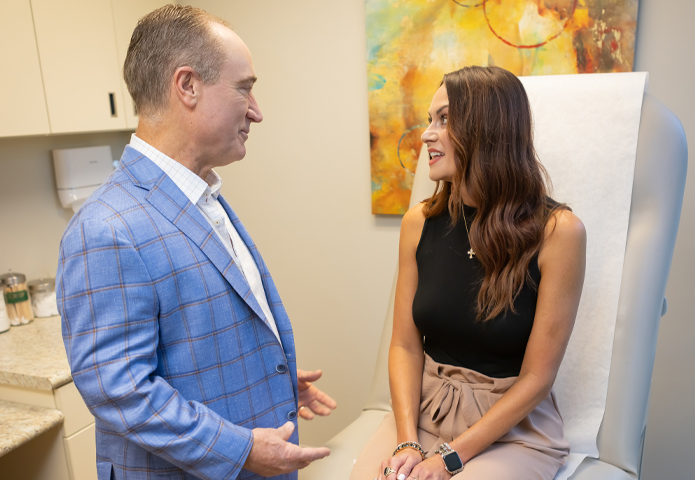Fat Transfer at Brantley Operative Aesthetics
Natural Enhancement With Stunning Results with Dr. Shelby Brantley
As we age, we lose tissue volume and elasticity; it’s a natural part of life. When you want to restore your youthful features and contours, you have natural options. Fat transfer has become increasingly popular for facial rejuvenation, restoring volume lost due to aging, enhancing breast and buttock size, and creating more balanced body contours. Under the skilled hands of Dr. Brantley, you can achieve the contours that flatter your overall figure and facial features to boost your confidence and help you feel amazing in your body.
At Brantley Operative Aesthetics in Flowood, MS, Dr. Shelby Brantley and our compassionate team are dedicated to helping you reach your aesthetic goals. Every fat transfer procedure is designed to enhance your body confidence and promote a positive self-image.
Are you interested in learning about how fat transfer can enhance your overall physique and boost your confidence? Contact us at (601) 387-9005 or request your consultation to begin your facial and body contouring journey today! We are located in Flowood, MS, near JAN International Airport and proudly serve patients from across the United States.
Quick Links:
Quick Facts
Anesthesia: General
Procedure Time: Around 1 to 2.5 hours
Recovery Time: Around 5 to 7 days
What Is Fat Transfer?
Fat transfer, also known as fat grafting or lipofilling, is an innovative cosmetic procedure that offers a natural approach to enhancing your appearance. This technique involves carefully removing unwanted fat from one area of your body, such as your abdomen, thighs, or flanks, and transferring it to areas where you’d like more volume or contour, such as your face, breasts, or buttocks.
What Areas Can Be Enhanced with Fat Transfer?
Fat transfer offers remarkable versatility in addressing aesthetic concerns throughout the body. The procedure can restore youthful fullness to aging faces, add curves to the body, and create more balanced proportions. Common treatment areas include:
- Face: Cheeks, under-eye hollows, temples, nasolabial folds, lips, and jawline to restore volume and reduce signs of aging.
- Breasts: Augmentation for subtle size increase, reconstruction after mastectomy, or correction of asymmetry.
- Buttocks: Enhancement for a fuller, more lifted appearance, also called a Brazilian Butt Lift.
- Body Contours: Hips, calves, and other areas to create smoother, more proportionate curves.
- Scars and Depressions: Filling indentations or irregularities from previous surgeries or injuries.
Whether you’re considering fat transfer to address age-related volume loss, enhance your natural curves, or achieve more harmonious proportions, Dr. Brantley will meet you with compassion and confidence to help you love the body you’re in.
What Are the Benefits of Fat Transfer?
What makes fat transfer particularly appealing is that it treats two concerns at one time: you reduce fat in areas where you don’t want it while simultaneously adding natural-looking volume where you do. Because the procedure uses your own tissue rather than synthetic fillers or implants, the results look and feel completely natural, with minimal risk of allergic reaction or rejection.
- Liposuction removes fat from areas that cause you discomfort.
- Permanent results that look and feel natural.
- Minimally invasive procedure with maximum aesthetic enhancement.
- No risk of allergic reaction or rejection.

Why Choose Dr. Shelby Brantley for Your Fat Transfer in Jackson, MS?
When selecting a surgeon for your fat transfer, experience, skill, and trust matter. Dr. Shelby Brantley combines decades of expertise with a compassionate approach, making him the surgeon of choice for thousands of women in Mississippi and beyond. With Dr. Brantley, your fat transfer isn’t just surgery—it’s a carefully tailored experience backed by skill, science, and genuine compassion for every patient.
Here are a few reasons patients choose Dr. Brantley:
Extensive Surgical Experience – Performed more than 20,000 procedures in plastic and reconstructive surgery.
Published Expert – Authored 50+ medical journal articles and abstracts, contributing nationally recognized research on silicone immunology, ultraviolet light exposure, liposuction, and abdominoplasties.
Prestigious Training – Magna cum laude graduate of the University of Mississippi; completed general surgery residency at UMMC and a plastic surgery fellowship at the University of Tennessee College of Medicine.
- Recognized Leader – Member of elite organizations including the American Society of Plastic Surgeons, American Society of Aesthetic Plastic Surgeons, and the American College of Surgeons.
National Recognition – Named to the RealSelf 500 list of top cosmetic surgeons worldwide, and voted Best Cosmetic Surgeon in the Jackson Metro by BOOM Magazine readers.
Compassionate Care – Known for his approachable bedside manner, dedication to patient safety, and commitment to restoring confidence and self-image.

Where Is the Fat Taken from During a Fat Transfer Procedure?
Fat transfer involves taking fat from a donor site on your own body and methodically placing it elsewhere. Generally, the fat is harvested from areas of your body where you have excess fatty tissue, commonly including areas like:
- Abdomen
- Thighs
- Flanks
- Hips
- Lower back
- Arms
During your consultation, you and Dr. Brantley will examine the areas on your body where you have excess fatty tissue to determine the best donor sites for your contouring goals.
What Should You Expect During Your Fat Transfer Consultation at BOA?
At Brantley Operative Aesthetics, we believe that a relaxed, unhurried consultation is the foundation of a trusting and successful patient relationship. During your visit, Dr. Brantley takes the time to get to know you – not just your aesthetic goals, but also your family, lifestyle, career, hobbies, and daily routine – to better understand your unique concerns and aspirations for fat transfer.
Dr. Brantley encourages your questions and values your input with the goal of empowering you to achieve natural-looking, personalized results that reflect your vision. By understanding your concerns, he focuses on how he can customize your fat transfer procedures to address your unique concerns and ensure your optimal outcome.
Dr. Brantley understands that physical issues that cause you grief can also have an impact on your emotional and mental health. As such, Dr. Brantley takes considerable time with each patient to ensure you feel heard and supported during your consultation and throughout your aesthetic surgery journey.
During your fat transfer consultation, Dr. Brantley will review and discuss:
- The areas you hope to enhance with fat transfer and the areas of excess fatty tissue that can be used as donor sites.
- Your expectations for plastic surgery.
- Your medical and surgical history.

Am I an Ideal Candidate for Fat Transfer Procedures?
Candidates for fat transfer procedures are those who are healthy and want to restore their overall appearance by redefining their facial features or restoring their body contours by transferring fat from one location to another.
Ideal candidates interested in fat transfer should:
- Be in good overall health.
- Have enough excess fatty tissue to use as donor fat.
- Be a non-smoker or willing to quit all nicotine at least 2 weeks before and after surgery.
- Have no medical conditions that may impair healing or affect general anesthesia.
- Have a positive outlook and realistic goals for their procedure.
- Understand the surgical risks and benefits.
Preparing for Your Fat Transfer Surgery
Before your fat transfer procedure, it’s important to be in good overall health to ensure beautiful results and a smooth recovery. Here are some tips to help you prepare for surgery.
- Maintain a Healthy Lifestyle: Continue your consistent exercise routine and follow a balanced diet rich in protein to support healing and maintain a stable weight.
- Stay Hydrated: Drink plenty of water in the days leading up to and following your procedure to support recovery and overall wellness.
- Medical Clearance: If required, schedule a visit with your primary care physician for a pre-surgical evaluation to ensure you are physically fit for surgery. Testing may include routine blood tests or an EKG. We will discuss this during your consultation.
- Medication & Supplement Restrictions: Dr. Brantley will review your medications, supplements, or vitamins during your consultation. You may need to stop taking anything that increases the risk of bleeding or bruising for 2 weeks before and after surgery, including fish oil, garlic, ginseng, vitamin E, Ibuprofen, or other anti-inflammatory medications.
- Discontinue Nicotine Use: If you smoke, vape, or use nicotine products, you must stop at least 2 weeks before and after surgery. Nicotine negatively impacts healing and increases surgical risks.
- Prepare Your Home for Recovery: This can include ensuring you have ample time off work, completing household chores prior to surgery or delegating to someone else, setting up a comfortable recovery space, preparing and freezing healthy meals, arranging for a meal delivery service, or filling prescriptions and purchasing supplies.
- Arrange for Help: Plan on having a responsible adult to drive you home and stay with you for at least 24 hours following surgery. For the first few days, you may also need help with childcare, pet care, or household tasks.
Flowood, MS, Fat Transfer Procedure Overview
On the night before surgery, avoid eating or drinking after midnight; however, take approved medications with small sips of water. Come to surgery freshly showered with Hibiclens, without makeup, lotions, or deodorants. Leave jewelry or contact lenses at home, and wear loose, comfortable clothing that is easy to take off and put on after your procedure. Depending on the characteristics of your individual procedure, you can expect your fat transfer procedure to take between 1 to 2.5 hours.
Pre-Op Review
Before surgery, carefully review your paperwork to confirm your surgery location and arrival time. At check-in, you may be asked to provide identification and emergency contact information.
Anesthesia Consultation
On the day of your procedure, you’ll meet with Dr. Brantley and your anesthesia provider to review your surgical plan and address any final questions or concerns. If necessary, an anesthesia consultation will be arranged before your surgery.
Incision and Tissue Work
Based on the surgical plan developed during your consultation, Dr. Brantley will perform liposuction in the donor areas to harvest the fat. Once the fat is harvested, he will purify the fat to isolate only the healthiest fat cells. Then, the fat is purified and ready, and he will strategically inject the purified fat into the treatment areas.
Sutures and Dressing
Dr. Brantley will place sutures and cover the incisions with a surgical dressing, which will remain in place until your first shower. If necessary for your treatment areas, you will be fitted with a compression garment to protect your incisions and your new contours.
What Should You Expect During Fat Transfer Recovery?
The recovery process after fat transfer involves several stages and requires careful attention to ensure optimal healing and results. Initially, you can expect some discomfort, fatigue, soreness, bruising, and swelling at the donor sites and the treatment sites. These side effects typically peak within 48 to 72 hours and then gradually improve. To manage discomfort, Dr. Brantley will prescribe pain medication and recommend appropriate over-the-counter options.
Immediately after surgery, your incisions will be dressed, and you will be fitted with a surgical dressing and compression garment to reduce swelling and support healing tissues. It is essential to wear this garment as much as possible, except when showering or laundering, for about two weeks or as directed by Dr. Brantley.
Most patients require about 4 to 7 days for initial fat grafting recovery and feel well enough to return to light work at that point. However, it is critical to avoid strenuous activities, such as vigorous exercise or heavy lifting, for 2 to 4 weeks to protect your sutures and promote proper healing. Light activities like walking or using a stationary bike are encouraged as soon as possible to improve circulation and support recovery. During follow-up visits, Dr. Brantley will monitor your healing and may recommend medical-grade scar therapies to help optimize scar appearance.
How Soon Will I See My Fat Grafting Results, And How Long Will My Results Last?
Many patients will notice a difference in their treatment areas almost immediately after the procedure. However, it’s important to note that the initial results will be obscured by swelling and bruising for the first few weeks to months. At roughly 6 months post-procedure, you will be able to see your final result.
At the 6-month mark, your fat survival rate will have largely stabilized, and the transferred fat will have integrated into the area and re-established a blood supply. After this time, your results are considered permanent. It is important to note that not all the transferred fat will survive. Generally, you can expect 50% to 70% of the grafted fat to survive.
Partner with Mississippi’s Premier Plastic Surgeon, Dr. Shelby Brantley
Dr. Shelby Brantley is one of the premier plastic surgeons in Flowood, MS, and he understands the challenges that many patients have faced before deciding to commit to plastic surgery. As experts in facial and body contouring procedures, Dr. Brantley and his team can help you enhance your overall appearance, increasing your confidence and body image.
Learn about fat transfer near me options in Flowood, MS, by calling (601) 387-9005 or completing our online form to schedule your consultation today!
Jackson Fat Transfer FAQs
Is fat grafting painful?
The fat grafting procedure itself is not painful, as you will be under local or general anesthesia. Following your procedure, you may experience soreness at both the donor sites and recipient areas, similar to the feeling after an intense workout. This discomfort is typically mild to moderate and easily managed with prescribed medication for the first few days. Many patients find they only need over-the-counter pain relievers after the initial 48 hours. Any tenderness generally subsides within 1 to 2 weeks as your body heals.
How is fat grafting different from dermal fillers?
While both fat grafting and dermal fillers add volume to enhance your appearance, they differ significantly in several ways. Fat transfer uses your own tissue, eliminating any risk of allergic reaction, while fillers are synthetic or naturally derived substances that your body will eventually absorb.
The results from fillers are immediate but temporary, typically lasting 6 months to 2 years depending on the product used, making it a perfect option for people who aren’t quite sure they want their results to be permanent. However, the volume required may be cost-prohibitive. On the other hand, fat grafting provides permanent results once the transferred fat establishes a blood supply.
Fat grafting requires a surgical procedure with some downtime and surgical risks, while fillers are non-surgical injections performed in-office with minimal recovery. However, fat transfer can address larger areas and provide more substantial volume restoration in a single treatment.
Dr. Brantley will work with you during your consultation to determine the most appropriate treatment for you.
Will I have visible scarring after fat grafting?
As with any surgical procedure, you should expect scarring. However, scarring from fat grafting is minimal and typically imperceptible. The incisions required for harvesting fat through liposuction are very small, usually just a few millimeters long, and strategically placed in discreet locations such as natural creases or areas easily concealed by clothing. The injection sites where fat is transferred are even smaller, often requiring no sutures at all and healing to nearly invisible marks.
Following your surgery, Dr. Brantley can recommend a medical-grade scar therapy to help minimize the appearance of scarring.
Can fat transfer be combined with other procedures?
Yes, fat grafting can be combined with other procedures to provide comprehensive rejuvenation. Many patients choose to have fat transfer performed alongside treatments like:
Combining procedures allows you to address multiple aesthetic concerns in a single surgical session, reducing overall recovery time and potentially lowering costs compared to staging procedures separately. During your consultation, you and Dr. Brantley will discuss your prioritized treatment areas and create a treatment plan that helps you look and feel your best.
What happens to transferred fat if I gain or lose weight?
Once transferred, fat cells that successfully integrate into their new location will behave like fat cells anywhere else in your body, meaning they’ll expand if you gain weight and shrink if you lose weight. Significant weight fluctuations can affect your fat transfer results, potentially altering the contours and proportions you achieved following the procedure. Maintaining a stable weight and staying committed to a sustainable diet and exercise routine will help preserve your beautiful results for years to come.
How do I choose a fat grafting surgeon?
Selecting a fat grafting surgeon in MS is a personal and important decision. Your surgeon should not only understand your aesthetic goals but also prioritize your safety and deliver consistently excellent results. It is, however, equally important that you find a surgeon you resonate with who makes you feel good about your body and your potential result. During your consultation, ask to view your surgeon’s before-and-after gallery to see the type of results they typically provide.
Another factor to consider is feeling comfortable and confident with your surgeon’s abilities. Look for someone who is transparent about potential risks and complications, has hospital admitting privileges, and is open to discussing complication management should any issues arise.
Fat grafting is a significant investment in yourself, and your surgeon should take every measure to ensure optimal outcomes. This includes identifying any factors that may affect your safety or results and developing a personalized plan for optimization before scheduling your procedure.
During your consultation, Dr. Brantley will ensure you are comfortable, discuss your potential outcome, and explain how he will prioritize your safety during your procedure and beyond.